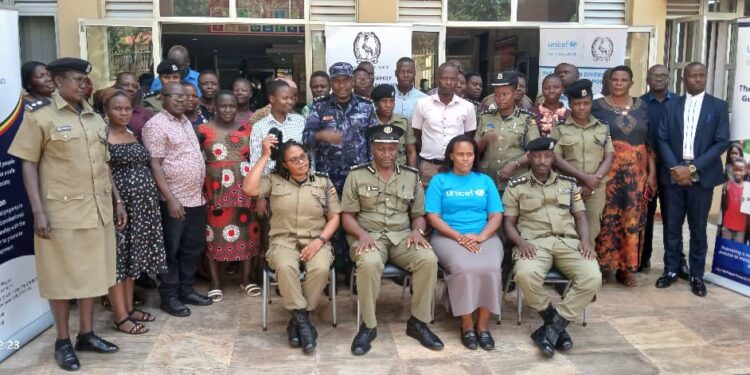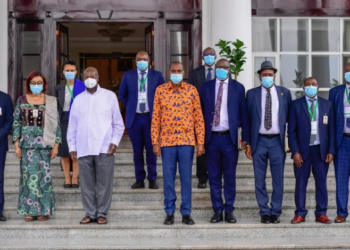One of the best approaches in the reduction and prevention of crime in Uganda is to avoid plunging the young generation into the criminal justice over petty offences which only serves to make them become real hard-core criminals in the near future.
The Senior Commissioner of Police (SCP) Dr John Kamya who is also in charge of Curriculum and Doctrine Development at the Uganda Police Force (UPF) headquarters at Naguru in Kampala contends that introducing young people into the criminal justice system can have severe and long-lasting consequences on their physical, emotional, and psychological well-being.
He lists some of the dangers and risks to include trauma and stress saying incarceration can be a traumatic experience, leading to increased stress, anxiety, and depression in young people.
Dr. John Kamya, a highly accomplished individual, holding a Doctorate degree in Human Rights from Makerere University, was speaking during the opening ceremony of a two-day training on the application of Children Diversion Guidelines and Data Collection tools at the Civil Service College (CSC)in Jinja City on Thursday 5th November,2024.
Quoting Dr. Laurence Steinberg, a renowned American psychologist who has written extensively on adolescent development and the importance of rehabilitation over punishment, John Kamya who once served as the Commandant Police Senior Command and Staff College Bwebajja, urged the police to change their approach from punishment to rehabilitation.
He also emphasized the importance of using discretion when dealing with child offenders, encouraging police participants from the Family and Child Protection Unit (FCPU) to explore alternative, user-friendly approaches.
“…instead of sending children to remand homes, reformatory homes, or jails where they may be negatively influenced by their peers, consider counseling and referring them to religious or cultural leaders, or headteachers who can provide further guidance and support.
Teacher-like in his presentation, Kamya highlighted the potential for children to change and grow, citing unnamed examples of individuals who were once considered problematic but have since become responsible and contributing members of society, even holding key positions.
This approach, he says prioritizes rehabilitation and community-based support over punishment and institutionalization which the police personnel commonly referred to as Mama/Baba Police must embrace.
According to experts and child activists, Kamya’s recommendations align with the principles of juvenile justice, which emphasize the need for age-appropriate and rehabilitative approaches when dealing with child offenders.
“…by providing children with access to counseling, education, and community support, we can help them develop the skills and values necessary to become positive contributors to society…”, he encouraged.
Earlier on Ms. Deborah Gasana from the United Nations Children Fund (UNICEF) Kampala office highlighted the collaborative efforts between UNICEF and the Uganda Police Force in promoting juvenile justice and child protection.
Giving a long history that spans over two decades of collaboration, Ms. Gasana emphasized the potential negative consequences for young petty offenders who come into contact with the criminal justice system, including missed opportunities for development and contamination with more serious offenders.
She used the occasion to inform participants that UNICEF has supported the development of diversion guidelines to help address these issues.
She announced that UNICEF has also helped the Uganda Police Force create a manual that will be incorporated into a training module for all police personnel at the Police Training School in Masindi.
SSP Jane Nakityo, the Commissioner in charge of Formal Education who was team leader at the ongoing training took participants through some of the key terms from the definition of a child to the legal and statutory instruments at national and international levels.
Presenting her paper under the heading, Child Growth and Development, Ms Jane Nakityo said the training is to equip police personnel with the knowledge and understanding of the diversion guidelines, data collection tools, and their application in handling child-related cases.
She said its other objective is to foster a child-friendly justice system by training police personnel to prioritize the best interests, safety, and well-being of children.
“…at the end of the two days, we expect the police personnel to be able to apply diversion guidelines in handling child-related cases, ensuring that children are diverted away from the formal justice system whenever possible…”, she stressed.
She also stated that it was to train police personnel to effectively use data collection tools to collect, analyze, and report data on child-related cases, ensuring informed decision-making and improved service delivery.
Other specific objectives are to enhance the investigation and documentation skills of police personnel in handling child-related cases, ensuring that cases are thoroughly investigated and documented.
“…we want to promote collaboration and referral among police personnel, other law enforcement agencies, and child welfare organizations to ensure a comprehensive and coordinated response to child-related cases…”, Jane Nakityo told the attentive participants.
What You Need To Know:
Children diversion guidelines refer to a set of principles, procedures, and standards that guide the diversion of children away from the formal justice system.
The guidelines aim to ensure that children who come into conflict with the law are dealt with in a manner that prioritizes their best interests, safety, and well-being.
Objectives of Children Diversion Guidelines.
Reduce Child Detention: Minimize the detention of children and promote the use of community-based alternatives.
Promote Restorative Justice: Encourage the use of restorative justice approaches that focus on repairing harm and promoting healing.
Ensure Child Participation: Ensure that children are informed, consulted, and participated in the decision-making process.
Foster Collaboration: Promote collaboration among law enforcement agencies, child welfare organizations, and community-based services.
Data Collection in Children Diversion.
Data collection in children diversion refers to the systematic gathering, analysis, and reporting of data on children who come into conflict with the law. The data collection process aims to:
Track Diversion Outcomes: Monitor the effectiveness of diversion programs and services.
Identify Trends and Patterns: Analyze data to identify trends and patterns in child offending.
Inform Policy and Practice: Use data to inform policy and practice decisions related to children diversion.
Improve Service Delivery: Use data to improve the delivery of diversion services and programs.
History of Children Diversion Guidelines:
The concept of children diversion guidelines has its roots in the United Nations Convention on the Rights of the Child (CRC): Adopted in 1989, the CRC emphasizes the need to establish laws, policies, and procedures that promote the best interests of children.
Beijing Rules: Adopted in 1985, the Beijing Rules provide guidelines for the administration of juvenile justice, emphasizing the need for diversion and community-based alternatives.
Children Diversion Guidelines in Uganda.
In Uganda, the children diversion guidelines were developed in:
In 2014 the Uganda Police Force, in collaboration with the Ministry of Gender, Labour and Social Development, developed the Children Diversion Guidelines.
In 2019 the guidelines were revised and updated to align with the United Nations Convention on the Rights of the Child and the African Charter on the Rights and Welfare of the Child.
The guidelines provide a framework for police officers, prosecutors, and other stakeholders to divert children away from the formal justice system and provide them with community-based alternatives.
Do you have a story in your community or an opinion to share with us: Email us at editorial@watchdoguganda.com













